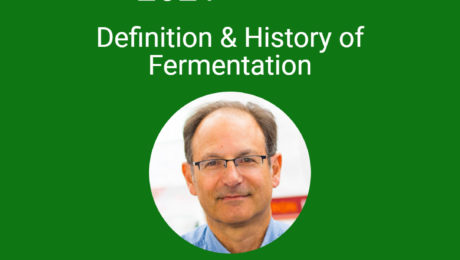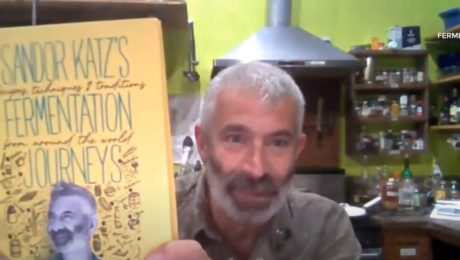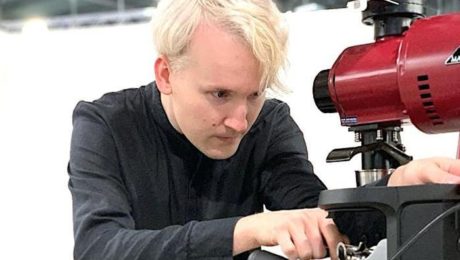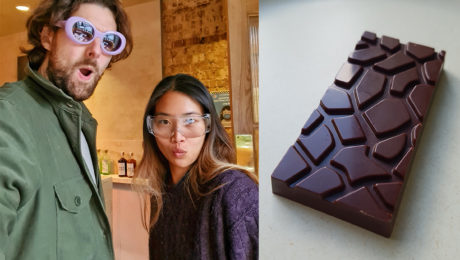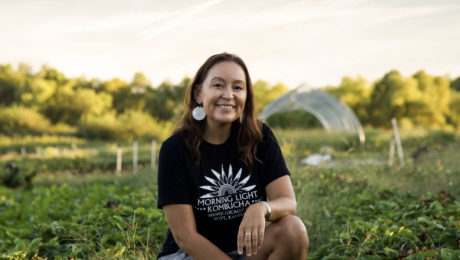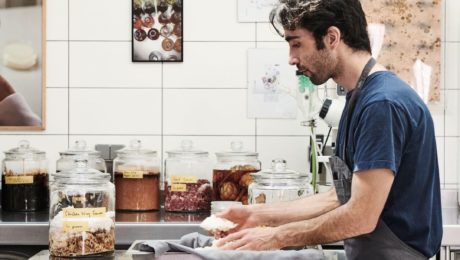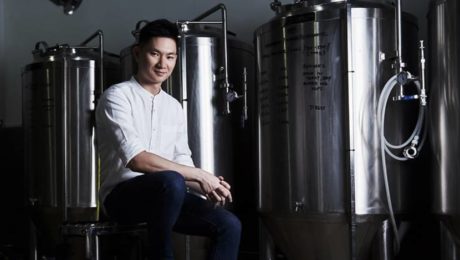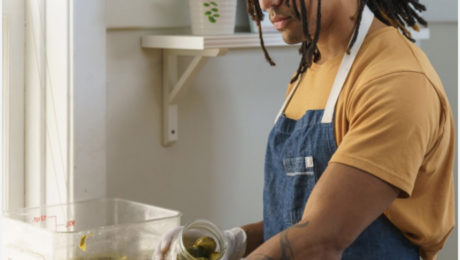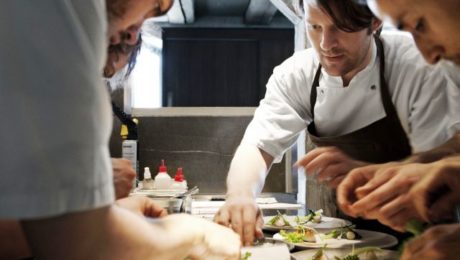Definition & History of Fermentation
“Human civilization simply would not have been possible without fermented foods and beverages…we’re here today because fermented foods have been popular for humans for at least 10,000 years,” says Bob Hutkins, professor of food science at the University of Nebraska (and a recent addition to TFA’s Advisory Board).
Hutkins was the opening keynote speaker at FERMENTATION 2021, The Fermentation Association’s first international conference. His presentation explored the history, definition and health benefits of fermented foods.
Cultured History
The topic of fermentation extends to evolution, archaeology, science and even the larger food industry.
“The discipline of microbiology began with fermentation, all the early microbiologists studied fermentation,” Hutkins says.
Louis Pasteur patented his eponymous process, developed to improve the quality of wine at Napoleon III’s request. The microbes studied back then — lactococcus, lactobacillus and saccharomyces — remain the most studied strains.
“What interested those early microbiologists — namely how to improve food and beverage fermentation, how to improve their productivity, their nutrition — are the very same things that interest 21st century fermentation scientists,” Hutkins says.
Hutkins is the author of one of the books considered gospel in the industry, “Microbiology and Technology of Fermented Foods.” He says that fermented foods defined the food industry. In its early days, it was small-scale, traditional food production that “we call a craft industry now.” At the time, food safety wasn’t recognized as a microbiological problem.
Today’s modern food industry manufactures on a large-scale in high throughput factories withmany automated processes. Food safety is a priority and highly regulated. And, thanks to developments in gene sequencing, many fermented products are made with starter cultures selected for their individual traits.
“But I would say that there’s been kind of a merging between these traditional and modern approaches to manufacturing fermented foods, where we’re all concerned about time sensitivity, excluding contaminants, making sure that we have consistent quality, safety is a vital concern and extensive culture knowledge,” Hutkins says.
Defining & Demystifying
Fermentation — “the original shelf-life foods” — is experiencing a major moment. “Fermented foods in 2021 check all the topics” of popular food genres: artisanal, local, organic, natural, healthy, flavorful, sustainable, entrepreneurial, innovative, hip and holistic. “They continue to be one of the most popular food categories,” Hutkins continues.
Interest in fermentation is reaching beyond scientists, to nutritionists and clinicians. But Hutkins says he’s still surprised to learn how many professionals don’t understand fermentation. To address the confusion, a panel of interdisciplinary scientists created a global definition of fermented foods in March 2021.
“Fermentation was defined with these kind of geeky terms that I don’t know that they mean very much to anybody,” he says.
The textbook biochemical definition of fermentation that a microbiologist learns in Biochemistry 101 doesn’t work for a nutritionist or clinician focusing on fermentation’s health benefits. The panel, which spent a year coming to a consensus, wanted a definition that would simply illustrate “raw food being converted by microbes into a fermented food.” The new definition, published in the the journal Nature and released in conjunction with the International Scientific Association for Probiotics and Prebiotics (ISAPP), reads: “Foods made through desired microbial growth and enzymatic conversions of food components.”
Fermentation in 2022
Hutkins predicts 2022 will see more studies addressing whether there are clinical health benefits from eating fermented foods. The groundbreaking study on fermented foods at Stanford was important. It found that a diet high in fermented foods increases microbiome diversity, lowers inflammation, and improves immune response. But research like this is expensive, so randomized control trials are few.
Fermented foods could also make their way into dietary guidelines.
“Fermented foods, including those that contain live microbes, should be included as part of a healthy diet,” Hutkins says.
- Published in Food & Flavor, Science
FERMENTATION 2021 Wrap-Up
Nearly 300 individuals from around the world participated in The Fermentation Association’s first conference, FERMENTATION 2021. The virtual event included 35 educational keynotes, presentations, and panel discussions from more than 60 speakers over three days. Topics ranged from the science of fermentation to the art of fermenting to create flavor, from how fermented products are selling at retail to what’s next in the world of fermentation.
“I’ve been in this field for 40 years and, in all honesty, this is one of the biggest honors I’ve received, to be the speaker for this opening meeting of this really cool organization,” said Bob Hutkins, professor of food science at the University of Nebraska. Hutkins presented the conference’s opening keynote, Definition & History of Fermented Foods.
Over five years ago, John Gray, TFA’s founder, envisioned a trade show for producers of fermented foods and beverages, to make those artisanal items a more prominent part of the retail space. John connected with Neal Vitale, TFA Executive Director, and the organization was born out of their collective vision. TFA has grown, with a robust website, biweekly newsletter,a series of webinars and, now, an international conference. TFA has an Advisory Board that includes food and beverage producers, academics and researchers, and food and flavor educators and authors. TFA has formed working relationships with a number of other like-minded trade associations and organizations, and established a Buyers Council to create an active dialogue with food and beverage distributors, brokers and retailers.
“I have to tell you what a thrill it is to have you all here to witness and to participate in the beginning of a dream coming true,” added Gray in his welcoming remarks. Gray is the chairman and CEO of Katalina Holding Co., a food incubator and parent company of Bubbies Pickles.
FERMENTATION 2021 content paralleled TFA’s primary missions: first, help consumers better understand fermentation and its potential health benefits; second, work to improve health and safety regulations as they pertain to fermented products and third, connect the science and health research communities with producers, supporting scientific research and for a better understanding of the “state of the art.”
What made FERMENTATION 2021 unique is that it was the first event to bring together everyone involved in the world of fermentation — producers, retailers, chefs, scientists, authors, suppliers and regulators. The conference was not a how-to fermentation education event, as TFA feels there are numerous, effective resources for the person looking to, for example, make kimchi or learn about using koji.
“”We were delighted with how well FERMENTATION 2021 met — in fact, exceeded — our goals,” said Vitale. “While we were disappointed that the continuing impact of COVID-19 kept us from meeting in person, we were gratified by how all the participants responded, interacted, and engaged during our three jam-packed days. And, with recording of all our sessions now available online for our registrants, we expect that energy and excitement to continue.”,
“Fermentation is experiencing a major surge of interest in restaurants and kitchens around the globe,” says Amelia Nielson-Stowell, TFA Editor. “Our conference was a major milestone for the industry and we are already in the planning stages for FERMENTATION 2022 next summer. And, assuming we will be able to meet in person once again, we plan to host a tasting and sampling event for consumers alongside our conference.”
- Published in Business, Food & Flavor, Health, Science
Katz on Fermentation, Ancient & Modern
When Sandor Katz was asked to teach his first fermentation workshops in the early ‘90s, he figured it would have only niche appeal. Instead, people filled his workshops, begging for more information and calling on him to host similar events all over the U.S. “People [were] hungry for more information on fermentation,” he says.
“Humans didn’t invent fermentation. Fermentation is a natural phenomenon that existed before we did,” Katz says, speaking from in front of a wall of ferments and spices in his home kitchen in Tennessee. “Fermentation is an essential part of how people everywhere make effective use of whatever food resources are available to them. Food fermentation is not precious; fermentation is practical.”
Katz was a keynote speaker at the FERMENTATION 2021 conference. He shared his personal journey into the subject as well as his thoughts on fermentation as a natural phenomenon.
Fermentation as Trend
Katz says people are excited about fermentation for different reasons — some have memories of fermenting with their grandparents and want to try it at home, others are immigrants wanting to recreate dishes from their native countries, some are farmers hoping to preserve a surplus of produce, others are interested in the health benefits and some are foodies chasing the delicious flavor.
He hates equating fermentation with trends, preferring the term “fermentation revitalization” — the demographics of people currently making fermentation “trendy” again hasn’t really changed in the last 30 years.
“Fermentation has been so important to food traditions everywhere, and yet because of factory food production, one-stop shopping convenience foods, fewer and fewer people were practicing fermentation,” Katz said, recalling his workshops in the early days. “It was becoming more mysterious to people. Now there’s no denying that fermentation is trending. There’s a heightened awareness of fermentation, but people don’t realize the products of fermentation have been so integral to how everybody, everywhere eats. Without even thinking about fermentation, people have always been eating products of fermentation.”
The “War on Bacteria”
But there has long been fear around fermentation from some consumers. Katz says many people “project their anxiety about bacteria onto the idea of fermentation.”
“For people of my generation and older, we never heard anybody say anything positive about bacteria. The degree that bacteria were talked about at all, it was about how dangerous they are and how much they need to be avoided. I grew up in a period that could be described as the war on bacteria, this idea that bacteria are pathogenic, bacteria are dangerous to us, bacteria must be avoided and you know we have an arsenal of chemicals that we can use to kill bacteria as needed to keep us safe.”
The U.S Department of Agriculture has never had a case of foodborne illness from fermented food or beverages, Katz notes. “Statistically speaking, fermented vegetables are safer than raw vegetables.”
Facing people’s questions and fears motivated Katz to write his first book, The Art of Fermentation. This month, he released his 6th title, Fermentation Journeys: Recipes, Techniques, and Traditions from Around the World.
Fermenting the Future
Katz is an advocate for decentralizing food production, replacing a global supply chain with local, farm-fresh sources. Though this will raise the cost of food, it will put fermentation as a key means of preserving a surplus of seasonal crops, Katz notes.
Even as more and more chefs and producers apply different processes to different substrates and play with flavor, Katz says the fundamental processes remain the same. Nothing new has been invented in fermentation, which dates back 10,000 years.
“Fermentation of the future grows out of the techniques and traditions of the past,” he says. “Anything you can possibly eat can be fermented, so I’m never surprised when something is fermented.”
Katz shared his story of fermenting a goat on the rural Tennessee farm he lived on in the ‘90s. After the animal was butchered, he took the leftover pieces and fermented them for a few weeks in a mix of miso, yogurt and sauerkraut juice. When cooked, the meat released a strong aroma, a scent that became legendary on the farm. But, Katz says, “It was delicious. Like many things, it had a stronger aroma than flavor.”
Health Benefits Come with Warning Labels
When asked about the curative health benefits of fermented foods, Katz does not mince words. He wrote in Wild Fermentation that fermented foods were an important part of his healing when he was diagnosed with HIV in 1991. Since then, numerous media outlets have twisted his story, writing that Katz cured himself from HIV with fermented foods.
“I have become much more cautious about how I talk about this,” he says. “There’s a lot of highly speculative information out there…and I’ve never seen data that would suggest that.”
Katz says he’s careful to rely on reputable scientific studies for data on fermentation’s health benefits. He says he’s read articles claiming kombucha will prevent hair from going gray. Pointing to his full head of gray hair, Katz smiles and says “When I started teaching about fermentation, my hair didn’t look like this. Time marches on.”
“Food has profound implications for our health and well-being and for how we feel, but singular foods are very rarely the cure to specific diseases. …There are many benefits to fermentation, whether it is simply from pre-digestion of nutrients that makes nutrients more bioavailable and accessible to us or whether it’s from the probiotics or whether it’s from metabolic byproducts which can be extraordinarily beneficial to us.”
- Published in Food & Flavor
Fermenting Coffee with Koji?
A two-time Finnish Barista Champion made headlines with his unique cup of joe at the World Barista Championship in Italy — a koji-fermented coffee.
Aiming to make better coffee than what’s available on the market, Kaapo Paavolainen (pictured) studied how he could maximize the flavor in coffee beans. “Sugar in beans is responsible for coffee’s inherent sweetness but the lack of it results in unpleasant bitterness. But the current methods can extract only 70% of available sugar,” he told Forbes.
After reading about koji in the books Koji Alchemy (by Jeremy Umansky and Rich Shih) and The Noma Guide to Fermentation (by Rene Redzepi and David Zilber), he realized koji can tap into the remaining 30% of sugar in beans.
Incredibly, this koji-based method was used on subpar coffee beans in experiments and still transformed the coffee. Umansky described the flavor as “deep, earthy and leathery. Depending on the roasting level of the beans, the flavor ranged widely from tropical fruits like pineapple and mango to chocolate and gingerbread. The mouthfeel was strikingly silky and luxurious like butter. The rounded, full-bodied texture made these tastes last very long.”
Paavolainen aims to scale the koji process with a partner farm in Columbia. This new coffee method could aid coffee farmers, many of whom are financially challenged and are struggling to maintain farms in the face of climate change.
Read more (Forbes)
- Published in Business, Food & Flavor
Chocolate Without the Cacao
Cacao is one of the most environmentally harmful and ethically dubious commodities produced on the planet. It plays a huge role in deforestation, uses an alarming amount of water and more than 2 million children work in cacao farms. Yet cacao hasn’t been reimagined the way other foods with similarly harmful footprints have.
“There’s a lot of ethical quandaries around the production of chocolate,” says Johnny Drain, PhD, co-founder of WNWN Food Labs. “Cacao is a huge contributor to climate change, and child labor and slave labor are hardwired into the supply chain.”
Drain’s nickname is the “Walter White of fermentation” because of his work helping pioneering restaurants and bars around the world incorporate fermentation into their food and drink. Now Drain can add “Willy Wonka of chocolate” to his resume. He is co-launching a cacao-free chocolate, next in the wave of alternative products designed to replicate flavor and texture without a harmful production cycle.
A Chocolate-Potato Connection?
WNWN (Waste Not, Want Not, pronounced “Win-Win”) happened by chance. About five years ago, Drain was boiling old, green potatoes, and leaned his head into the steam. He was surprised it smelled like chocolate.
“I had this light bulb moment where I thought ‘There must be some compounds within the skins that are also found in cacao and chocolate.’ I wondered — ‘Could I make chocolate from potatoes? What other weird and wonderful things could make chocolate?’” Drain says.
WNWN plans to release a small-run batch of their chocolate next month. Drain and co-founder Ahrum Pak, a former investment banker and fellow fermenter-turned-food-activist, are calling the product category choc.
WNWN’s choc ingredients are proprietary until its formal release but, as with traditional chocolate, they are plant-based and fermented. Drain describes them as familiar, whole ingredients that are common in an average person’s diet.
“It’s not a Frankenstein, lab-created product, mixing this potion with that potion. We take whole ingredients, we ferment them just as we would chocolate, then we end up with this delicious chocolatey paste that goes into a quite conventional chocolate-making procedure,” Drain adds.
WNWN also replaces cocoa butter — made from cacao pods — with plant-based oils. Cocoa butter is what gives traditional chocolate a silky, creamy texture as it melts in your mouth.
Fermented Flavors
At the heart of choc’s flavor, though, is fermentation.
“Cacao is fermented to make chocolate in the same way our product is fermented. We use similar, friendly microbes to create complexity,” he says. “We’re recreating that flavour profile of chocolate that we all know and love using the same fundamental techniques that are used to make chocolate.”
High-quality chocolate contains roughly 600 different flavor and aroma molecules. Cacao fermentation involves lactic acid and acetic acid bacteria, along with various yeasts, to create its flavor.
“If you didn’t have that cocktail of microbes, you would end up with something that only tastes vaguely like the chocolate we know and love,” he adds. “At the heart of this is fermentation. The product that we have, if we produced it without the fermentation processes, it wouldn’t taste anything like chocolate, just like if you eat a raw cocoa bean or even a roasted, unfermented cocoa bean, it doesn’t really taste like chocolate. You have to have that very complex cascade of chemical reactions, made possible by the fermentation, to get the final chocolate flavour.”
The Next Big Alt Movement?
Drain is quick to point out WNWN is not the only company trying to create what he and Pak have coined “alt-chocolate.” Three companies — QOA, Voyage Foods and Cali-Cultured — all officially launched in the past three months.
Some of these companies have been operating in stealth mode for a number of years but made official launches once word of competitors began to circulate. QOA and Voyage appear to be using approaches similar to that of WNWN. CaliCultured is using a syn-bio precision fermentation route to modify yeast cells to produce lab-grown cacao cells that are genetically identical to those found in the wild.
Drain says he’s encouraged by the other companies.
“It’s exciting that there’s multiple people working in this space,” he says. “Look at the plant milk space or alternative protein space — there’s definitely plenty of room in this marketplace too, and collectively we are all doing this because we care about the ethical and environmental damage being wrought by the current cacao supply chain.”
European and American consumers historically dominate chocolate sales, but chocolate sales all over the world are increasing.
Drain and Pak feel that a shake-up in the industry at the top is needed. Huge international producers are responsible for the vast majority of global chocolate. Mars, Nestle and Hershey promised over 20 years ago to stop using child laborers, but reports say the problem continues.Similarly, these companies pledged a decade ago to source more sustainable chocolate, but negative environmental problems from cacao continue to increase.
“The way in which we consume food has to change. It’s unrealistic that millions of tons of mass-produced cacao is somehow ethically- and sustainably-produced,” Pak says.
Drain adds; “So, really, we’re not anti-chocolate, we’re anti-big-chocolate produced in unethical, unsustainable ways.”
Recreating Food
Chocolate is merely the first challenge that WNWN wants to address. Coffee and vanilla are next, foods with similar human rights and sustainability concerns. The company is building a software system that can ideate fermentation pathways for creating sustainable, flavour-identical analogs to delicious – but unsustainable – products.
“When you really start looking at how most of the world’s food is produced and consumed, there are so so many cases where it’s produced in a really terrible and damaging way,” Drain says. But “the market wouldn’t have been ready for a product like this five years ago. People are becoming much more aware of where their food comes from. People are thinking about ‘How do I make my purchasing habits, my diet better for the planet in a way that I don’t have to sacrifice the flavors and taste that I love?’ There will be work to do. But people are more receptive now that fermentation is more of a household name than it was five years ago. I think the fact that more people want to remedy these challenges is brillant.”
Drain will be speaking FERMENTATION 2021 on “The Alt-Universe”
- Published in Business, Food & Flavor
Q&A: Melinda Williamson, Morning Light Kombucha
Melinda Williamson has always been fascinated by plants — she grew up watching her mother make baby food with produce from the garden, later studied medicinal plants in college and dedicated her career as an ecologist to researching microbial communities in soil.
So, when Williamson became extremely sick with an autoimmune disease eleven years ago, it was not surprising that she turned to plants. She began making green smoothies daily and, after a student shared a bottle of it with her, drinking kombucha.
“I became really conscious about what I was putting in my body, really focusing on where my food was coming from,” says Williamson, founder of Morning Light Kombucha in Hoyt, Kansas. “I started researching my illness, and found that a lot of stuff stems from the gut. It brought me into this world of ferments.”
The health-scare-turned-health-revival changed the course of her life. Mother of a then-young child, Williamson moved back to Kansas to raise her daughter closer to family. She took a language program job on the Prairie Band Potawatomi Nation reservation in her hometown, then spent her hours off work fulfilling a dream of running her own business. She perfected a home-brewed kombucha and began selling it at local farmers markets, gas stations and yoga studios.
The pandemic easily could have shuttered a small brewery like Morning Light which, prior to 2020, Williamson ran on her own. But she designed a website, opened an online store, started curbside delivery and launched a canned line — and sales grew by 25%. By the end of 2021, Morning Light Kombucha will start shipping nationally and, by the end of next year, they plan to break ground on a 4,000-square-foot facility on the reservation.
“What I really want to do is get my product into more native communities, so they can find healing just like I found healing,” says Williamson, head of the only Native American kombucha brand. “That’s more important to me than seeing my product on the shelf of Wal-Mart or Target. I’m not in it to be rich. I still plan on living in my little house here on the reservation close to my family. I just want to do something that has meaning and an impact.”
Below is an edited Q&A between Williamson and The Fermentation Association.
TFA: Where do you get your ingredients? You forage some of the ingredients yourself on the reservation.
MW: We go out and harvest wild blackberries, wild raspberries, chokecherries and pawpaws mostly on the reservation. There’s edible plants everywhere, it’s surprising the places you can find them. We just went to Overland Park, which is the city near us, to forage for pawpaws.
Some of the ingredients like gooseberries, those we find in small quantities. If we go out and we only get four cups of berries, we may not make any kombucha with it. But sometimes I’ll make a little five gallon batch.
Most of our ingredients, we partner with local farms in Northeast Kansas. It comes down to the importance of knowing where our food comes from. My goal was to always work with local farmers and source ingredients locally, I knew I wanted that as part of my business foundational value.
As much as possible, we keep sustainability at the forefront of everything that we do, being really conscious about our footprint. It’s really nice because, being in Northeast Kansas, people aren’t thinking about stuff like that. They’re more and more thinking about where their food comes from, but it’s been really nice to have those conversations with the community and get people really thinking about supporting the local farming economy, supporting local business.
A big part of it really comes down to what we’re showing our kids. Before my daughter was born, I had her when I was 23, I was eating a lot of fast food. I was like “I’m free! I’ve got a job! I can buy and eat whatever I want!” I was eating so much junk food. And then I got pregnant and wanted to feed her properly. I grew my own garden and started making my own baby food, just like my mom modeled for me. Food is so important, it’s a constant conversation in my life and in my business.
TFA: Do you make seasonal flavors then?
MW: We launched our canned kombucha line in February. Prior to that, we were doing about 100 flavors a year, so now that we’ve launched our canned kombucha line, we’ve had to whittle that down because we have to have four flavors constantly. Our rotations have diminished a little, but we’re still putting out about 60 flavors a year.
Our berry flavors are our most popular — blackberry lemongrass and strawberry. Seasonally, our smaller batches that people love are mulberry, that is a top seller. People also love the ginger and chokecherry flavors.
TFA: How do you sell your small batches? Are you selling them retail or filling kegs on site?
MW: We sell direct-to-consumer, like at the farmers markets and events. We don’t have a brewery that’s open to the public. We do curbside pickup, that was something that was developed in response to the pandemic. We could no longer sell directly to the consumer, so we just started doing doorstep delivery, then the curbside pickup. Basically, people just have their empty bottles in their trunk and call us and we come out and grab their bottles, and swap them for new, filled bottles. It’s contactless, but we still got to see our customer and wave. We’ll probably continue to do that, we’re still in this pandemic, and the most important thing is to keep our community safe and our elders up here safe. We will continue taking all precautions to protect people around us until we hit a safe spot.
TFA: A portion of your sales goes back to the native communities. Tell me about that.
MW: We donate where we feel like the money would be used best, things that we’re passionate about and things where we see we can make a difference. For example, we just recently donated to one of the residential school survivor nonprofits. We’ve taken clothes to Standing Rock Sioux Tribe where they were protesting the Dakota Access Pipeline, we’ve donated to our Boys and Girls Club here on the reservation, we’ve donated to our youth soccer teams, we’ve donated to First Nations programs in Canada.
TFA: Morning Light Kombucha is a trademark American Indian Food product. What does that mean?
MW: So that trademark American Indian Food falls under the Inter-Tribal Agricultural Council, which is a subset under the USDA. The program really highlights American Indian food producers. You apply and then the program supports you in different ways. We’re able to network with other American Indian food producers, brainstorm together and talk about what we’re experiencing and try to make movements when it comes to distribution. The program is really big with international exporting, so all the American Indian food producers have the opportunity to attend large trade shows internationally, they’ll fly us there, ship our products and give us the opportunity to have a booth and get our product in front of people who are interested in American Indian food products. I’m not ready for something that big, I am so small, but I’ve gone to a domestic show through the program. I went to a food show in Chicago and got in front of a lot of people who are interested in my kombucha. We have really big plans in 2022 to expand our facilities, and hopefully expand domestically.
TFA: What are Morning Light Kombucha’s plans for 2022?
MW: I just bought 10 acres here on our reservation. My plan is to break ground and build a production facility. It will be three times the size of what we’re in now, which will be really, really nice. There’s a pond on the side, we’ve got a creek, timber, a lot of foraging areas. The plan is to build an off-the-grid brewery, too, so it will help us provide more jobs in our community and it will allow us to do some of the things that we haven’t been able to do.
I mentioned sustainability is a big part of what we do. We compost 100% of our brewery waste, but I have to truck it to my house to my compost pile because, where we’re at now, we just can’t compost large quantities at our site. The waste water from our water filtration system, it’s totally usable water, but we don’t have any place to store it currently. Our waste water is not like gray water, it’s clean water that’s just wasted during the filtration process, it’s usable. For every one gallon that’s filtered, there’s three gallons that’s wasted. It’s so insane, it killed me when I found that out. Once we are in our new facility we can begin to recycle it on property. We have this dry pond. Our plan is to see if we can get it lined, divert the waste water in there and start filling the pond.
TFA: Scaling will be big for you in 2022.
MW: I know, I just hired three employees recently because it’s just been me for the past few years. I work part-time for our language department, and my kombucha business has been my side hustle. In the past year, I’ve realized the potential. People really like my brand and they’re noticing it and requesting it. So I thought “Maybe I could grow this brand into something bigger.”
TFA: I am beyond impressed — you have been building a kombucha brand by yourself?!
MW: Family is always there for me. My boyfriend is at the market, my nephews help with anything I need, it’s a family affair even though I never really had anybody on my payroll until recently. Now I’m getting to a point where I need help all the time. I hired my sister as my brewery manager, she keeps a tight ship. It’s allowed for me to really work on expansion while she’s running operations at the brewery.
TFA: Yours is still the only Native American-owned kombucha brand.
MW: With my business, I like to think that I’m also giving a voice to native issues. I would never want to be an authority on native issues, but there’s a lot of things going on in Indian country that people don’t see in the mainstream media and mainstream social media. If I can build a brand that can also bring awareness to these things, that’s really important to me.
TFA: You have a background in academia. What got you interested in ecology before switching to kombucha?
MW: I’ve always loved science, I’ve always loved the outdoors, I’ve always been super eco-friendly, I’ve always been conscious about our impact on the earth. I love animals, I love nature. I was taking some of my general ed classes at Haskell (Indian Nations University) and took an ethnobiology class. I just fell in love. I ended up transferring to Kansas State and got my degree in environmental biology (then a masters degree in rangeland ecology and management from Oklahoma State University.) I went with my boss from K State to Oklahoma State and ran the grassland ecology lab for years.
TFA: Where do you see the future of fermentation?
MW: There’s an explosion. I see it continuing to grow and expand and people are coming out with really innovative ways to bring fermentation to the table. Like Wild Alive Ferments out of Lawrence, Kansas. We’re a part of a local CSA with them. The owners just came out with an apple kraut flavor, an autumn harvest with spices that is so amazing.
In the U.S. especially, we have a lot of people who are sick with illnesses or cancers and autoimmune issues and I think we’re starting to see more people look at what they’re putting in their bodies. They’re realizing the importance of gut health, the importance of ferments, and that it affects so much more than just your gut. It’s a movement — and I’m really excited about it.
- Published in Business, Food & Flavor, Health
Jason White:“It’s Cool to be a Fermenter”
While more chefs and cooking enthusiasts are experimenting with fermentation, they’re skipping the basics and jumping straight to complicated dishes. The foundational steps of cooking are fine-tuned only with time and patience, with hours spent mastering the simple recipes first, according to Jason White, director of the fermentation lab at Noma restaurant.
“It’s just as important for you to make a delicious pickle and a wonderfully balanced kombucha as it is for you to make an incredibly long-aged batch of miso,” White says. “We can never forget that, whenever we start approaching these biological processes and these fermentation processes, that we also take advantage of the beginning stages of learning each individual step along the way. I can’t tell you how important it is for a person who’s emerging into the art of fermentation to stop and pause for a minute and take the opportunity to connect dots. Each microbe that we’re using to ferment things has some kind of mechanism, and an ingredient that we’re going to ferment has a composition that benefits that microbe.”
White spoke at Harvard University’s Science & Cooking Lecture Series, on the topic Fermentation: A Springboard for Modern Gastronomy. He began his director role at Noma last year and has since helped the world-famous restaurant earn its third Michelin star in September.
In his lecture, White stressed observational skills — honed in the early years of learning to ferment — are one of the most important qualities for a fermenter. The best way to “really understand what an ingredient is and what it has to offer a microbe” is through the senses. When you cut into the ingredient, does it feel dry? Does it smell of essential oils? Does it taste overripe?
“Fermentation is one of those weird occurrences in nature where humans intentionally create something only to watch it decompose, and when it decomposes it produces something that’s more valuable to us,” White says. “I am not a chef, I am not a scientist, I am a dreamer and I am a fermenter and my life journey is going to be dedicated to the act of microbial processing.”
From Texas to Denmark, Fermenting with Local Agriculture
A native of Albuquerque, New Mexico, White began a career as a fermentation consultant for restaurants and distilleries in Texas. He worked for two years at Noma before returning to the U.S. in 2019 as head of the food research lab at Audrey restaurant in Nashville.
The early days of his career in gastronomy weren’t spent in beautiful, state-of-the-art kitchens like those at Noma. White’s first experiences as a professional fermenter were spent cooking in a small wooden shed in the Texas heat.
Environment is a critical element to fermenting. Texas is vastly different from the areas that are the globe’s cornerstones of fermentation — Japan, Korea and Taiwan — and which had inspired White. Texas, for example, doesn’t have a huge variety of mushrooms or produce — but it does have chilies and lots of grains.
“I found a lot of joy adapting traditional recipes into something that was based off Texas agriculture,” White says. Much of his fermentation in those days was driven by koji, which grows well on the grains common to Texas.
White learned a key lesson that he incorporates in his cooking: use the local ingredients and agricultural systems available in the area.
“Every single ingredient on earth, you’re going to find something that is valuable to a fermentation process,” White adds. “Even if we can’t consume it as humans, you can use the fermentation process to make it more delicious.”
Respecting the Past, Propelling the Future
Fermentation has been around since the beginning of humanity. When we ferment, White says, we’re recreating the environment and the processes traditionally used where the ferment was first discovered and practiced.
“And, as fermenters, we are also carrying the knowledge of these practices through the generations,” White says. “And where we are with fermentation, it’s kind of like emergent pop cultures. It’s cool to be a fermenter.”
White characterizes his fermentation style as “somewhere between a control freak and a naturalist.” Fermenters have a “huge sense of responsibility” to maintain food safety, carry on traditional processes and teach new fermenters. …We are protectors of knowledge, we are protectors of ingredients and we are protectors of history.”
Whether fermenting at home for personal use or in a production facility for consumers, “We are all still changing the way microbes are evolving and we’re all still participating in the ancient act and it is truly beautiful….if anyone in this room wants to ferment, you are literally the future of fermentation.”
During his presentation, White demonstrated how to ferment persimmons. In Texas, local farmers would bring persimmons to the restaurant where he worked. They were hard and unripe, not flavorful enough to eat raw, so White soaked them in amazake, a fermented rice beverage. During his lecture, White sliced bright orange persimmons for an amazake bath.
“The beauty in this whole entire thing isn’t how complex it is,” White says. “Fermentation doesn’t have to blow your mind, you don’t have to be like ‘Oh my god, it’s completely transformed, it’s something I don’t even recognize and it makes my palate explode with flavor.’ No. Fermentation could also be something that respects an ingredient and leaves it as is. But enhanced fermentation is something that can make something that is not as valuable as it should be more valuable again. You can turn something that would maybe go in the trash…into something very delicious.”
- Published in Food & Flavor
Reviving Singapore’s Fermentation Culture
Singapore’s so-called “Prince of Fermentation” wants his country to develop “its own brand of fermentation culture.” Tan Ding Jie says Singapore’s traditional ferments are often left out of “the gospel of fermentation.”
“Cinchalok, fish sauce, fermented bean curd, fermented bamboo shoots – these are all very interesting ideas. People who are more mature have been quite ready to adapt koji from Japan and red yeast rice from Asia in their Western restaurants – so I think we should also be able to adapt or loan some of their ideas and use them in our cuisine.”
Tan Ding Jie, a researcher for Singapore’s Agency for Science, Technology and Research, is currently pursuing a master’s degree in food science. Jie consults for different Singapore restaurants and bars on how to use ferments in their menus. He created a fish sauce and nata de coco at the Michelin-starred Labyrinth restaurant, and created kombucha-infused cocktails for Gibson, one of Asia’s top bars. He started his own brand, Starter Culture, and teaches fermentation workshops and sells his own kombucha.
In an interview with Channel News Asia, Jie said he thinks there’s “much to be discovered from looking into our Southeast Asian culinary heritage. … I think Singapore is unique because we haven’t been afraid to say, ‘Let’s learn what are the best practices in the world today, and then apply it to our local context.’ If you look at Southeast Asian ferments, it’s also very simple – we took what immigrants brought over and said, ‘All right, that’s the history, let’s make it local.’”
Read more (Channel News Asia)
- Published in Food & Flavor
Q&A: Sebastian Vargo, Vargo Brother Ferments
Sebastian Vargo was an up-and-coming chef on the Chicago food scene when the Covid-19 pandemic hit and shuttered restaurants. Laid off from his job as head chef at Merchant Restaurant, Vargo experimented with different gigs — yoga teacher, realtor, even t-shirt graphic designer — but kept coming back to his passion: creating food.
So Vargo and his fiancée, Taylor Hanna, launched Vargo Brother Ferments. They produce a creative line-up of fermented condiments, sauces and beverages, including items like a pickled garlic sauce, chipotle beet sauerkraut, Mighty Vine tomato vinegar, Concord grape kombucha and a Bulgarian yogurt with fermented strawberry jam and miso peanut butter.
“Ultimately, I’m a flavor chaser,” Vargo says. “Fermentation is not really an obligation, it’s a necessity to really unlock certain flavors.”
Most of what they make is seasonal, created from fresh ingredients sourced locally from Chicago community gardens or out of Vargo’s backyard garden. Flavors heralding back to Vargo’s childhood are also featured. Collard greens kimchi is one example, featuring the leafy vegetable frequently served at Vargo’s family dinner table as he grew up in Detroit.
“You can’t help but find a little bit of nostalgia in what you make. Flavors are so connected to memories,” Vargo says. He recalls his mother’s buttery cornbread, her pinto beans flavored with a smoked ham hock and his grandmother’s braised short ribs with sauerkraut. “We were this African-American family in the Midwest in the ‘90s with Southern heritage, so some of my food preserves some of that history. With fermentation, there’s an intersection of both physical preservation and historical preservation. My fermented vegetables are an homage to the past, presenting certain vegetables in interesting and complex ways.”
Vargo and Hanna currently run their business from their home kitchen, selling over Instagram, at farmers markets and through collaborations with local restaurants around the Chicago area. They’re nearing the end of a Go Fund Me campaign to help move Vargo Brother Ferments into a commercial kitchen and, eventually, a storefront. .
Below is an edited Q&A between Vargo and The Fermentation Association.
The Fermentation Association: How did you first get into cooking?
Sebastian Vargo: My origin is with my grandmother. My mom worked really hard, she worked nights and then she was going to school as well. My grandmother was in our household a lot, she taught me and my brothers [the namesake behind Vargo Brother Ferments] a lot of life skills, how to box, how to play basketball, how to cook. I have fond memories of eating sauerkraut as a child out of a coffee mug with a fork. She was my earliest inspiration, I have fond memories of my grandma in the kitchen.
TFA: And how did you get into fermentation?
SV: My grandma introduced me to sauerkraut. It was such an exciting flavor, I hadn’t experienced the brininess of lactic fermentation, the way it feels on my tongue and cheeks. My mom loved to take us to local delis and we loved Reuben sandwiches. We’d go to a lot of Jewish delis in southeast Michigan, and they had salt brine pickles. That was a real fermented pickle, that flavor is something, too, that really kind of jump started my interest in fermentation.
And then, just working with cool chefs. A new part of my mind was unlocked at every restaurant. Great chefs helped cultivate my love of fermentation. Being in the industry in Chicago is so cool. Every last one of us, we’re all trying to experiment and see what we can do with flavors. When I worked for Stephanie Izard at Girl & the Goat, we were doing kimchi for certain dishes. At Schwa with Brian Fisher and later Wilson Bauer, we made our own yogurt and fermented our leeks, our apricots. And then when I worked for Tony Quartaro at Dixie, he was really pushing the envelope with this Southern-style restaurant where we took inspiration from around the world in a way and applied it to this Southern technique. We had some peaches come in that were underripe, we couldn’t use them for the actual dish, so instead he mixed it with some rum and taught me how to make a vinegar out of it.
TFA: What took you from Detroit to cheffing in Chicago?
SV: It was one Le Cordon Bleu commercial. I was young, I was in a bit of a crossroads and I made the decision to go to the Le Cordon Bleu culinary school in Chicago. I was working at the Salvation Army at the time and I got on the Megabus with my little thrift bags and maybe $800. I had no plans, I found out $800 will not get you an apartment in Chicago, so I stayed in hostels. Before I got enough money for culinary school, I worked as a canvasser to make money.
TFA: March 2020. You are the head chef at Logan Square’s Merchant and your fiancée was cooking at the Ace Hotel. Then Covid-19 lockdowns happen. Tell me how your lives changed.
SV: Merchant was the first restaurant where I was head chef, it was fun. We made our own hot sauces, we fermented pickles. But once I had the call that we were closing for Covid, I was ready to figure something out. I was a little bit burnt out from the industry at the time. I was ready to leave, it’d been a lot of pressure and a lot of stress for a while. So, like a lot of Americans, we took the unemployment. I had never been on unemployment. Being unemployed gave me a chance to finally reset. I was working up to 120 hours a week cheffing around. Now I could see what else is out there.
The whole time I was looking outside of the industry, me and Taylor were still doing a lot of experiments in the kitchen. We were making a lot of bagels, making pickles. I have a friend Joe Morski who runs a one-man sandwich operation called Have a Good Sandwich. It’s like a rotating sandwich club in Chicago. Meanwhile, I was trying to start a pickle club, and I asked him if he wanted to serve my pickles in the lunch pack for his sandwiches. That was my first foray into getting my pickles out there. From there, we just started peddling our jars.
TFA: What was the transition to your own business?
SV: To this day, there’s so few fermented, unpasteurized pickles on the market. It wasn’t even a search for a niche, it was something I love to do and I was excited to share my flavor palette with the public. Fermentation is a fun way to be creative, to use it as a platform for new dishes, to play aground with colors. It’s definitely been a great medium to pursue my love of food, of art. Feeding people is my love language. And fermentation is definitely something that’s going to live on forever. It’s wellness, it’s never going to go out of style.
TFA: Tell me about your G-Dilla pickle. That’s a customer favorite. What makes it so special?
SV: The G-Dilla pickle is a flagship that’s always in season. The name G-Dilla, we have blank labels and I didn’t want to write “Garlic Dill” each time. So I started G-Dilla as an homage to J-Dilla, a great producer [and rapper from Detroit].
The taste is akin to a Jewish deli, a garlic dill pickle, the one that would accompany a Reuben sandwich. I just take it kind of a step further with the herbs and the garlic. We use black tea in our pickle brine, it is a fun way to add tannins to the mix which provides that nice, crunchy skin. We really enforce the flavors through fresh herbs, fresh dill from our backyard, parsley, grape leaves, fresh bay leaf and we add lots of garlic and toasted block peppercorn and mustard seed. Maybe a little gochujang, some turmeric. You bite into one and you’re getting that loud crunch and you’re just getting that lactic acid zing that’s electrifying the flavor. It makes you stop what you’re doing, you can’t talk through it, you have to finish chewing and enjoy the whole experience. It’s been a journey — I think back to the first pickle I made to now and it’s something I’ve kept at, I’m a student of the game, always striving to learn more techniques and refine what I’m doing.
TFA: Why do you think more and more chefs are exploring fermentation?
SV: I think so many chefs are seeing the flavor benefits alone. Food fermentation offers a more nuanced flavor that you just can’t achieve the same way. Fermentation is in everything that we do, everything that we eat. There is really an endless source of inspiration and flavor for chefs. We’ve seen the interest pick up in fermentation, but it’s not a fad in the food world. Fermentation is something that is here to stay, with the recent explosion and interest in it, fermentation will find a nice settling place in food.
TFA: What do you think is the future of fermentation?
SV: I would like to see a future in which fermentation is no longer just a trending topic, something that everyone acknowledges for its real health benefits. So people aren’t just taking a probiotic gummy, they know they can get probiotics easily through so many foods. Society is at a place where we are not quite as healthy as we should be. Maybe we can make fermentation convenient, maybe we can show people that it’s not hard, we can show folks that there’s food you can have that has enhanced flavors and there’s something in fermentation for everyone.
- Published in Business, Food & Flavor
Noma Finally Earns 3rd Michelin Star
Fourteen years after earning two stars from the Michelin Guide, Noma was finally awarded the illustrious third star.
“After so many years of working together, to finally achieve something like this is extremely special,” says René Redzepi, chef and co-owner of the Copenhagen-based restaurant, during Michelin’s ceremony for Nordic countries earlier this month. Redzepi said the announcement left him surprised and flabbergasted. “I’m completely blown away, it’s a new feeling for me. This opportunity happens once in your lifetime.”
Long lauded as one of the top restaurants in the world, Noma has an innovative fermentation lab and test kitchen that creates wildly imaginative and ingenious dishes. Their summer menu featured an edible candle made with cardamom, saffron and a wick of silvered walnut; a salad made with reindeer penis; and a cold-pressed beetroot juice served in a flower pot adorned with a ladybug made from raspberry and black garlic .
The reactions from food industry professionals echoed the same sentiment — the third star was overdue.
James Spreadsbury, restaurant manager at Noma, said during the ceremony that the staff at the restaurant has been patient. “At some point, we kept on and didn’t expect anything would change. But we were still so proud of what we did and believed in what we did. After so many years of working together, to finally achieve something like this is extremely special.”
Redzepi was also honored by Michelin. The Chef Mentor award, given annually to a chef sharing their knowledge to help others, was presented to him by Peyman Sabet, the vice president of business development for Michelin.
“It’s really about innovation and making the path for a new generation of chefs,” Sabet said.
Redzepi said he was humbled to receive the award. He noted that, when Noma opened 18 years ago, “I was a terrible leader…when you are in the industry, you find yourself becoming a head chef and you don’t have the tools to actually figure out how are you doing to do this, how are you doing to lead and inspire a team.”
He said years ago he “promised himself this is not who I wanted to be.”
“One of the most enjoyable things I have in my professional career is to see someone that’s been a part of your own success, but when they leave they have their own success. That’s really really enjoyable.”
Noma is proud of their alumni and highlights them on their website. Reads the webpage: “Our chef René was himself a stagiaire [a cook who works briefly, for free, in another chef’s kitchen] around the world before opening Noma. It is a part of sharing ideas and knowledge that is quite special in our trade. We wouldn’t want to be without stagiaires and we believe that everyone that has been through Noma shares in part of our success.”
Former Noma chefs include: David Zilber (nowat bioscience company Chr. Hansen), Thomas Frebel (head chef at INUA in Tokyo), Dan Giusti (founder of chef training company Brigaid), Matt Orlando (head chef at Amass Restaurant in Copenhagen), Søren Ledet (owner and restaurant manager at Geranium in Copenhagen) andMads Refslund (head chef of ACME in New York City)
- Published in Business, Food & Flavor

